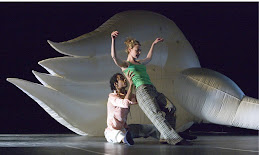Lanonima Imperial
Esplanade Theatre Studio, Sábado
Tara Tan
Como las alas gigantescas, inflables que cuelgan perezosamente sobre el escenario, este trabajo abstracto crece sobre las cosas de las que están hechas los sueños. Con un escenario oscuro y desnudo, unas pinceladas de escenografía y cuatro personas, el director Juan Carlos García creó un universo lleno de ideas en Variacions Al•leluia. La pieza de 60 minutos estaba basada en los elementos de pesadillas de los niños y los cuentos para antes de ir a dormir.
Cuando la audiencia entró en el teatro, los bailarines estaban ya allí, calentando y olvidados de nuestra presencia asustada. El director anduvo en el escenario, murmullando instrucciones a uno de los bailarines.
Desde el principio, García deformó el sentido de fantasía y realidad del público. En una escena, un aullido, la bailarina con el pelo afeitado enfrentó su imagen en un espejo encima de un carro giratorio. Su reflexión la acechó y ella saltó de manera amenazante en la plataforma en su búsqueda.
Más tarde, la estrella de rock española Murfilla "luchaba" contra un bailarín alado. Rasgueando su guitarra eléctrica y liberando gemidos guturales, pisó la espalda del ángel caído.
Otro bailarín convulsionó rodeado de cabezas de maniquí empaladas mientras Murfilla golpeaba un cubo vuelto hacia arriba como una niña irritable.
Los tres bailarines poseían fuertes personalidades. Miryam Mariblanca rápida como el rayo correteando a gatas a través del escenario era como un jaguar. Yester Mulens estaba desgarbado, haciendo virajes arrodillado mientras Olga Clavel lució sus miembros desordenados balanceandose y su diestra flexibilidad.
Viendo los dúos parecía que la audiencia asistía a un diálogo interno donde los cuerpos abrazaron los temas de la sensualidad y el misterio religioso. Los bailarines no se adhirieron al beat o melodía de fondo electrónico; el baile no se apoyaba ni en reglas ni en la razón. Pero era la fuerza con el trabajo de García: la ambigüedad.
El enfrentamiento de esta zarza de atormentadas imágenes se pareció al encuentro del camino durante una noche cubierta de niebla sin postes indicadores o direcciones claras. Usted tiene que abandonar la exposición razonada y seguir su corazón.
--------------------------
VARIACIONS AL•LELU1A
Lanonima Imperial
Esplanade Theatre Studio, Saturday
tara tan
Like the giant, inflatable wings which lolled lazily on stage, this abstract work grows on the stuff dreams are made of. With a dark and bare stage, a smatter¬ing of props and four people, director Juan Carlos Garcia created an evolving universe of ideas in Variacions Al•leluia (Variations Hallelujah). The 60-minute piece was based on the nightmarish elements of chil¬dren's bedtime stories.
When the audience entered the theatre, the dancers were already there, warming up and oblivious to our startled presence. The director walked onto the stage, mutter¬ing instructions to one of the dancers.
From the beginning, Garcia distorted the audience's sense of fantasy and reality. In one scene, a yowling, shaven-headed dancer confronted her image in a mirror atop a revolving trolley. Her reflection stalked her and she leapt menacingly onto the platform in pursuit.
Later, Spanish rock star Murfilla "bat¬tled" a winged dancer. Strumming her elec¬tric guitar and releasing guttural wails, she trod on the back of the fallen angel.
Another dancer convulsed while sur¬rounded by stoic mannequin heads im¬paled on sticks as Murfilla beat an up¬turned bucket like a petulant child.
The three dancers conveyed strong per¬sonalities . Miryam Mariblanca's light¬ning-quick scamper on all fours across the stage was like that of a jaguar's. Yester Mu-lens had gangly, limp-kneed swerves while Olga Clavel showed off wildly swing¬ing limbs and dexterous flexibility.
Watching their duets was like listening in to an internal dialogue where bodies em¬braced the themes of sensuality and reli¬gious mystique. The dancers did not ad¬here to the. beat or melody of the electron¬ic soundscape; the dance leaned on neither rules nor reason. But that was the strength in Garcia's work: ambiguity.
Confronting this bramble of haunting images was like finding your way through a smoggy night with no signposts or clear directions. You have to abandon rationale and follow your heart.





